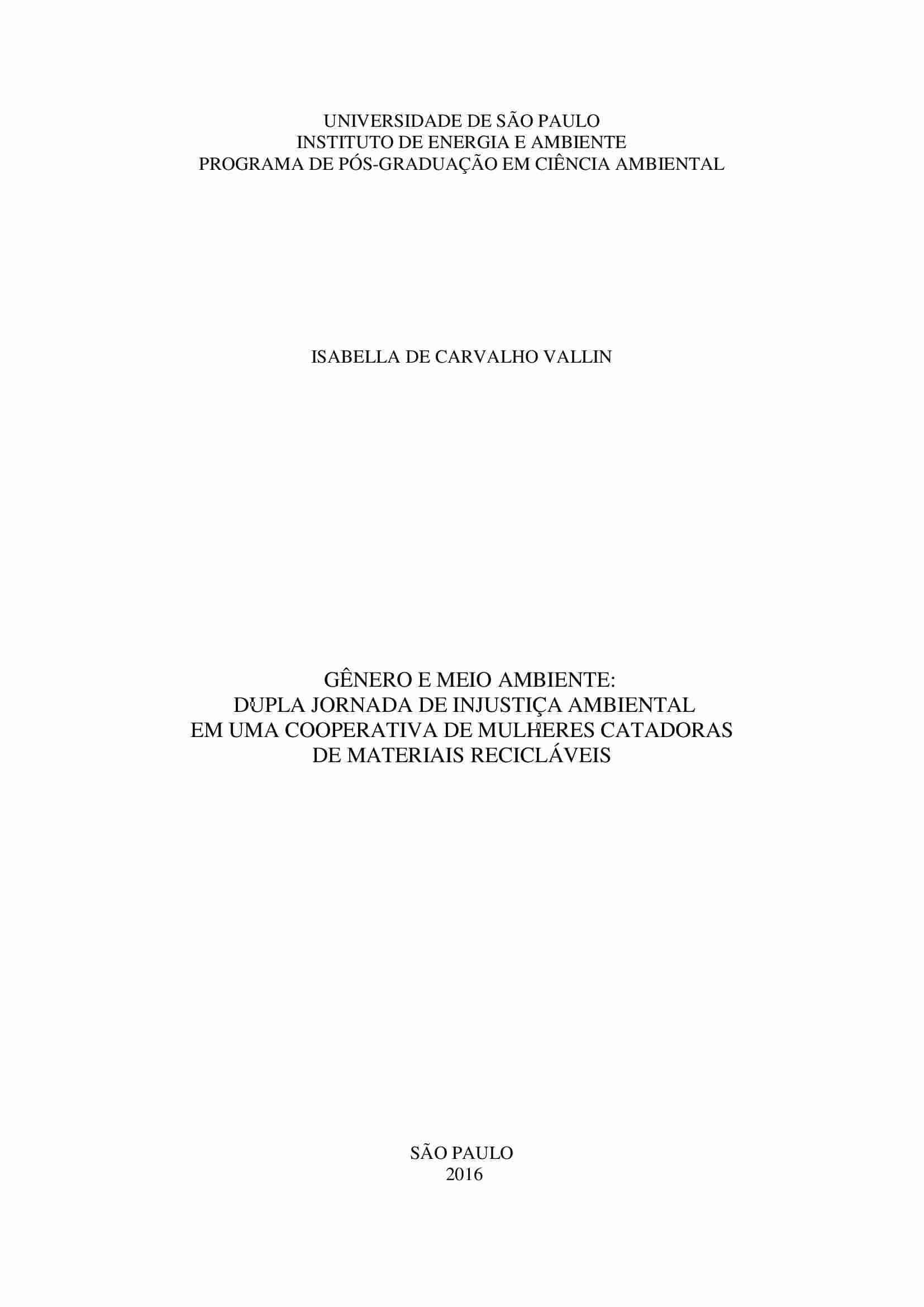Gênero e Meio Ambiente: A dupla Jornada de Injustiça Ambiental em uma Cooperativa de Mulheres de Catadoras de Materiais Recicláveis.
em português
ABSTRACTS:
English
VALLIN, Isabella de Carvalho. Gender and Environment: the double burden of environmental injustice in a cooperative of women of recyclable materials in São Paulo. 2016, 152. Master thesis (Master in Environmental Science) - Environmental Science Graduate Programme - Institute of Electrotechnics and Energy, University of São Paulo, Brazil, São Paulo, 2016.
This thesis aimed to understand the relationship between gender and environment among women waste pickers of a cooperative of recyclable materials in São Paulo. To understand this relationship, the concept of Environmental Justice was chosen as framework, showing the disproportional dynamic of environmental conflicts that affect the most marginalized and vulnerable people, marked with social inequality due to class, race and gender. In addition, studies discussing the Sexual Division of Labor were also used, considering that women are particularly disadvantaged because of their double burden, when the reproductive work is free and invisible and the productive work is devalued.
The Extended Case Method was used as methodology and the women cooperative was observed for three years. The data collection was made using the narrative interview technique and sixteen women waste pickers were interviewed. The data analysis used narrative analysis postulates.
The results showed that the women waste pickers who are spatially segregated and residents of Jardim das Flores slum are exposed to multiple risks: geomorphological risks of slipping and washouts; proximity of high-voltage power lines and; low infrastructure conditions linked to sanitation and garbage collection. Due their reproductive shift, the women spend more time in home and consequently in the slum, rising their vulnerability of those risks. Further, the wish to conciliate the double burden was also responsible for their work as waste pickers, with a female perpetuation in the scavenging activity. Then, the women are more exposed to occupational risks and the burden of environmental inequality in recycling chain.
In conclusion, women waste pickers are exposed to a double burden of environmental injustice: one related to habitational risks and one to precariousness of labor and occupational hazards. Thus, there is a interweaving of social inequalities historically imposed by patriarchal logic to keep the foundations of the current economic system, and the black women, householder and poor are who bear the environmental damage to maintain that system.
Português
VALLIN, Isabella de Carvalho. Gênero e Meio Ambiente: A dupla Jornada de Injustiça Ambiental em uma Cooperativa de Mulheres de Catadoras de Materiais Recicláveis. 2016, 152. Dissertação (Mestrado em Ciência Ambiental) – Programa de Pós Graduação em Ciência Ambiental – Instituto de Energia e Ambiente da Universidade de São Paulo, São Paulo, 2016.
Buscou-se nesta pesquisa entender as relações entre gênero e meio ambiente no cotidiano das mulheres catadoras de materiais recicláveis de uma cooperativa do município de São Paulo. Para tanto, procurou-se compreender essa relação a partir dos espaços de moradia e trabalho das catadoras. Como fundamentação teórica foi adotada a Divisão Sexual do Trabalho e a Justiça Ambiental. O método utilizado foi o Estudo de Caso Estendido e a técnica de coleta de dados primários a Entrevista Narrativa. Foram entrevistadas dezesseis mulheres catadoras cooperadas. Para a interpretação dos resultados seguiu-se os postulados da Análise de Narrativa.
Este estudo mostra evidências da situação de injustiça ambiental nos espaços de moradia e trabalho das catadoras entrevistadas. Além disso, demonstra que a dupla jornada de trabalho dessas mulheres leva a uma injustiça ambiental por gênero na catação. Também foi observada a relação entre a maternidade e o ingresso e permanência das catadoras na atividade.
A análise da dupla jornada de trabalho das mulheres permitiu identificar três trajetórias distintas entre as catadoras entrevistadas: catadoras estruturais, catadoras conjunturais ocasionais e catadoras conjunturais por conveniência. A partir das diferenças e similaridades observadas entre os três grupos de mulheres catadoras percebeu-se que fatores como a trajetória familiar, vulnerabilidade social e segregação espacial urbana foram os principais motivos que as levaram à catação. Verificou-se, ainda, que as mulheres estão mais expostas aos riscos ambientais justamente pela dupla jornada de trabalho.
Dessa maneira, considerou-se que a presença dos fatores de injustiça ambiental na dupla jornada de trabalho caracteriza o que foi denominado neste estudo de “dupla jornada de injustiça ambiental”. A jornada reprodutiva associada aos riscos ambientais ligados à habitação e a jornada produtiva referente aos riscos ocupacionais e à precariedade no trabalho.
View list of all: Research Reports

